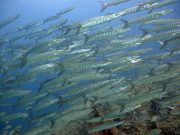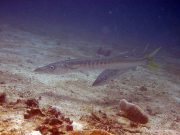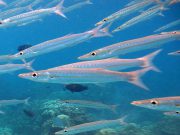Diving with Barracudas
Lanta Marine Life | Sphyraenidae
Barracudas are found world-wide in all warm and tropical waters, and are usually spotted in shallow water close to coral reefs and seagrass beds. There are four species regularly spotted while diving from Koh Lanta.
Fast, powerful, and known for their often fearsome appearance, they have long, thin, elongated bodies, with some species growing up to 2 m.
The upper body is generally grey or silvery coloured, with a dark blue or dark green colouration, and the lower body is whitish.

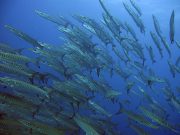

Body markings vary by species, typically with stripes, chevrons, spots and blotches helping to distinguish species from one another.
Barracudas have two short, widely separated dorsal fins, a forked tail fin, and small scales. Their fins may be yellowish or dusky.
The characteristic pike-like head is long, thin, and pointed, with a large under-bite in many species. Large, sharp, fang-like teeth protrude noticeably from the jaw, creating a menacing and threatening appearance.
Some species, such as the great barracuda (Sphyraena barracuda) are usually seen alone in shallow parts of the reef around Koh Lanta, however other species can be seen both in small groups, and in very large schools of several thousand individuals.
Barracudas are ambush predators, mostly lying in wait to prey on smaller fish. Although incidents are rare, the great barracuda has been known to attack swimmers by mistake.
Remove shiny jewellery and diamond rings when diving or snorkeling, as these objects are known to attract a great barracuda's attention and may appear attractive to them.
4 species found on this page:
Bigeye Barracuda
(Sphyraena forsteri)
The Bigeye Barracuda is very common at both the Bida Islands and the Koh Haa Islands, particularly around Koh Haa Lagoon, where large schools are seen on almost every dive there.
The Bigeye Barracuda is a long silvery fish, often with a yellow or greenish stripe running from the mouth, through the eye, to, or nearly to, the tail fin base. Above the stripe are often a series of short diagonal bars of a similar colour to the stripe. The upper back (around the dorsal fin) is also the same colour as the mid-body stripe.

Sphyraena forsteri @ Koh Haa
The lower body is lighter than the upper body. The eye is large, and the lower jaw slightly protrudes beyond the upper jaw. There is a small dark blotch at the base of the pectoral fin, and the forked tail fin usually (but not always) has a very faint dark margin.

School of Bigeye Barracuda @ Koh Haa
The Bigeye Barracuda grows to 65 cm, but is usually observed in the 25 cm - 35 cm range. This species feeds nocturnally on fish, shrimp and squid, but is often seen in large schools close to coral reefs during the day. These schools can sometimes be very large.
Blackfin Barracuda
(Sphyraena genie)

Sphyraena genie @ Koh Bida
The Blackfin Barracuda has a silvery body with a dusky to dark tail fin with dark margins. The rear dorsal fin and anal fin are also often a dusky to dark colour.
The body is long, tube-like, and the lower jaw protrudes beyond the upper jaw. There are about 18 - 22 dark chevron markings on the sides.
Blackfin Barracuda grow to 100 cm, but more usually observed in the 50 cm - 80 cm range. We sometimes see this species alone, but also in very large schools of 1,000+ individuals.
This species is a nocturnal feeder, with schools likely dispersing to hunt at night.
Pickhandle Barracuda
(Sphyraena jello)
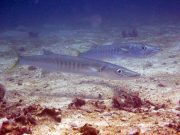
Sphyraena jello @ Koh Haa
The Pickhandle Barracuda has a very long silvery body with a yellowish tail and a huge mouth, with the lower jaw protruding significantly beyond the upper jaw.
There are around 10 - 20 wavy dark vertical bars along the side of the body.
Pickhandle Barracuda can grow to 150 cm, but more often seen 80 cm - 100 cm. The diet includes fish and squid.
Usually solitary, however occasionally we can see schools of several hundred in the shallows just outside of the reef area.
Great Barracuda
(Sphyraena barracuda)

Sphyraena barracuda @ Koh Haa
The Great Barracuda has a long, silvery tube-like body, large and very pointed teeth, and a lower jaw which protrudes beyond the upper jaw. The body has scattered dark patches and blotches.
When resting near a reef or the sandy bottom, this species can display a barred or mottled pattern to aid camouflage. There may be large black blotches on the tail fin and dorsal fins, especially the rear dorsal fin.
The Great Barracuda grows to 180 cm, but more commonly observed 60 cm - 80 cm.
The Great Barracuda is an ambush predator, feeding on fish and squid. Usually seen solitary, but occasionally in small groups.
Diving with Barracudas around Koh Lanta
Scuba Diving & Snorkel Trips
If you'd love a chance to spot Barracudas on one of our daily high season diving trips from Koh Lanta then send us an email to info@diveandrelax.com.
Join our high season speedboat dive trips to some of Thailand's best dive sites and enjoy small groups, short journey times, with a focus on great personal service, safety and fun.
Not yet a certified diver? Learn to Scuba Dive on Koh Lanta with the 3 day SSI Open Water Diver course.
Book online to save 10% on dive trips and scuba courses on Koh Lanta.
Find Out More
Indo-Pacific Marine Life Guides
- Allen, G., Steene, R., Humann, P., DeLoach, N. (2003) Reef Fish Identification, Tropical Pacific. Jacksonville, FL., USA: New World Publications, Inc., ISBN 1-878348-36-1.
- Humann, P., DeLoach, N., (2010) Reef Creature Identification, Tropical Pacific. Jacksonville, FL., USA: New World Publications Inc., ISBN 978-1-878348-44-9
- Debelius, H. (2013) Indian Ocean Reef Guide. Frankfurt, Germany: IKAN - Unterwasserarchiv, ISBN 978-3-939767-52-7.
- Debelius, H. (2004) Nudibranchs and Sea Snails, Indo-Pacific Field Guide. Frankfurt, Germany: IKAN - Unterwasserarchiv, ISBN 3-925919-51-1
- Erhardt, H., Knop, D. (2015) Corals Indo-Pacific Field Guide. Frankfurt, Germany: IKAN - Unterwasserarchiv, ISBN 3-925919-69-4.
- Veron J.E.N., Stafford-Smith M.G., Turak E. and DeVantier L.M. (2016). Corals of the World

